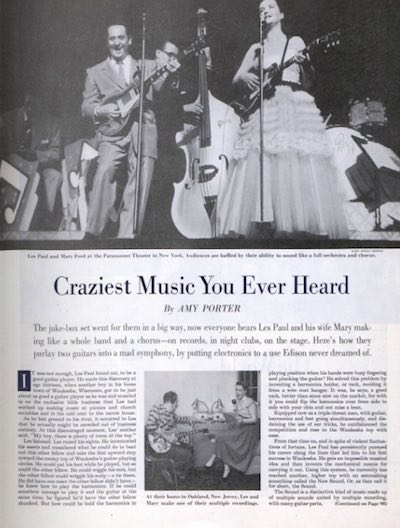The Legacy of Les Paul’s “Crazy” Music
On the anniversary of Bob Dylan’s controversial introduction of the electric guitar to the Newport Folk Music Festival, we recall one of the pioneers of the electric guitar.
In 1953, there was nobody on Billboard’s Top 30 list who sounded like Les Paul and Mary Ford.
Their music was a unique combination of swing, country, boogie-woogie, and rock-and-roll, all wrapped in a sleek, heavily produced sound with airless acoustics. Their songs featured lightning-fast guitar playing, curious sound effects, and a whole chorus of Mary Ford’s voice all singing the same notes.
This was electronic music, developed by Les Paul, a relentless innovator and one of those rare musicians with technical skill and musical talent. He pioneered recording techniques that would become standard today: multi-tracking, reverb, and overdubbing.
Not only did he bring musical sound into the modern era, he was (pardon the pun) instrumental in developing the electric guitar. Despite the legends, it was not invented by Les Paul. As the Post article from January 17, 1953, “Craziest Music You Ever Heard,” explains, that credit goes to Leo Fender. But Les, working with the Gibson Guitar Corporation, led the development of solid-body electric guitars.
Between 1951 and 1955, he and his wife, Mary Ford, recorded 13 songs that made Billboard’s Top 10 lists. But just as quickly as they achieved notoriety, they lost it. After “Hummingbird,” in 1955, there were no more chart-topping hits. The two divorced in 1964.
But Les Paul’s reputation never faded. Long after this article appeared, fans convinced Paul to return to performing at the age of the age of 69. He was still performing at the age of 88, despite having a right arm bent permanently at a 90-degree angle — the result of an auto accident in 1945 — and an arthritic left hand that only allowed him to use his ring and pinky fingers.
Today, Les Paul’s contributions to the music industry can be heard in the work of artists like Paul McCartney, Eddie Van Halen, Eric Clapton, Jimmy Page, Jeff Beck, George Benson, and Al Di Meola. All have acknowledged their debt to Les, both for his innovations in guitar style and his recording techniques that gave music its modern sound.

Featured image: Les Paul and Mary Ford at the Paramount Theater in New York. (Photo by Hans Knopf for the January 17, 1953 issue of the Post)